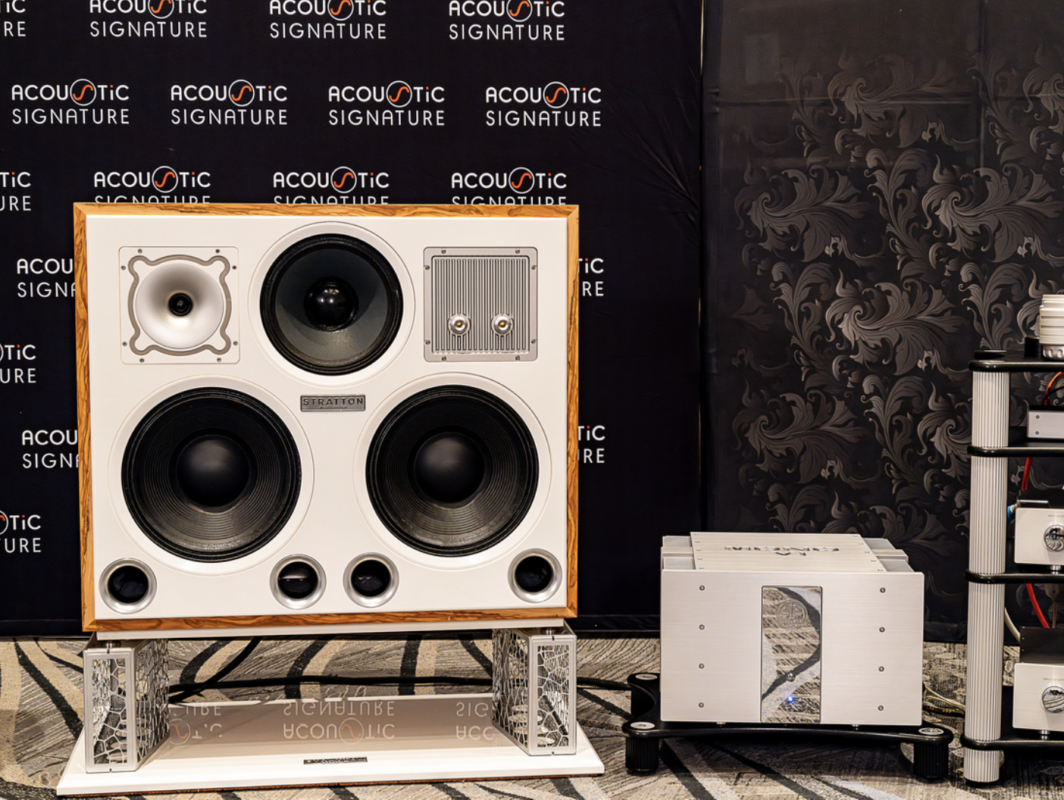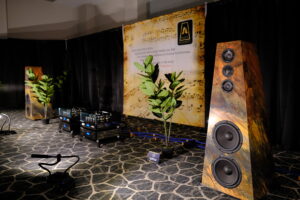Best Intros at CES: Vandersteen Model Seven and Wilson MAXX Series 3 Loudspeakers
- SHOW
- by Jonathan Valin
- Jan 19, 2009

Contrary to what some people may think (see my Magico M5 blog), I did listen to other ultra-high-end speakers besides the Magico M5 at this year’s CES, and after the M5 the two I thought best (there is a third but you will have to wait for our show issue to learn what it is) were the $68k Wilson MAXX Series 3 driven by Boulder electronics and the $45k Vandersteen Model Seven driven (marvelously) by Aesthetix electronics and the Clearaudio Statement turntable (there was no digital source in the room).
Although both speakers took me utterly by surprise, I’ll begin with the Vandersteen since it is such a dramatic departure from previous Vandersteen designs.
Technologically, the Model Seven is a huge step away from 70s/80s thinking into the twenty-first century for designer Richard Vandersteen, who has been working on this project for better than three years. As Robert has already noted in his blog on this speaker, the powered 12″ woofer in the “New School” Model 7 is the same as the woofer in the “Old School” Model 5, but just about everything else is different. The midbass, midrange, and tweeter are now made from a three-layer carbon-fiber/balsa wood/carbon-fiber sandwich (an unusual combination but, when you think about it, not really that much different than a carbon-fiber/Rohacell sandwich).
The pretty little enclosure is made entirely from carbon fiber, five layers of “skin” bonded to a carbon-fiber skeleton. There is an “ambience tweeter” on the back of the Seven, which Richard Vandersteen says you can use if it helps (although he generally doesn’t).
Since I brought my own vinyl to the show I can comment with some confidence about the sound of the Model Seven, which was just as revolutionary as its build. On Norah Jones’ “Come Away With Me” (from Live From Austin Texas), for example, the Seven sounded very neutral, open, and high in resolution, with exceptional low-level dynamic nuance on Jones’ voice and excellent control in the bass. (This is a cut that can test woofers, easily making them sound out-of-control since the Fender bass is, in fact, rather too big and fat. Here the bass was just right and superbly integrated with the rest of the speaker.) There was no sense of a cottony scrim overlaying the sound and obscuring very-low-level detail, as there has been (for me, at least) in previous Vandersteen models. Indeed, I wrote down in my notes: “Right up there with the MAXX III for best intro at CES.” There was a liveliness, presence, and breathiness to the sound, without a hint of darkness. Though they weren’t quite as “there” or as “transparent” as MartinLogan CLXes or Magico M5s, the Sevens were nonetheless superb–the Audio Research of full-range transducers.
The Wilson MAXX Series 3, on display in two rooms driven by Boulder electronics and Lamm electronics, was just as surprising, innovative, and impressive to me as the new Vandersteen Seven.
Using technologies developed for the Alexandria II, the MAXX III now has two rotatable/forward-backward-adjustable head units (housing separate midrange/tweeter combos) that purportedly allow the listener to maximize group delay by precisely time-aligning the mids/tweets to the listening position. (This idea isn’t new. Four or five years ago I reviewed the Ascendo M-S loudspeaker, which also allowed for time-alignment of its drivers via an ingenious forward/backward-adjustable head unit.)
The MAXX Series 3 also uses new midrange units (“simplified” versions of the mids in the Alexandria 2), relocates the crossover to the bass module, and employs X-material. Outside of the M5 I’d have to say that the Wilson MAXX Series 3 was the best sound I heard at CES 2009.
In the past big Wilson loudspeakers have generally sounded a bit “Old School” to me–which is to say, designer-colored. Always sensationally detailed and fantastically, almost aggressively dynamic, they were also a bit “hi-fi” with a hot mid-treble, virtually no top treble, a huge midbass, and an overall darkish palette. This profile made for a sensationally visceral and detailed presentation, but not a particularly neutral one–like the sound of studio monitors blown up to giant size.
Well…that ain’t the case anymore. The Series 3 is the most neutral Wilson I’ve ever heard (understand I haven’t heard the Alexandria Series 2), flat in frequency response, neutral in color, spacious in dimensionality, and still highly detailed. Gone are the studio-monitor-like aggressiveness and darkness and forwardness. On a cut like “Rainy Night in Georgia,” the 3s reproduced Captain Luke’s big bass baritone with extraordinary realism. (This is a big dark voice that can sound too dark and chesty and smoothed of throaty detail on many speakers–not here. Here the balance of chest and throat were just right. Same story on Dean Martin’s voice.)
I would have to say that the Wilson (at least in the Boulder room,where it sounded more neutral but less purely beautiful than it did in the more-gorgeous-sounding but darker Lamm room) was just a mite mechanical for all its virtues–just a little dry and clinical compared to, oh, a TAD Model One (although more realistic than a Model One). Still this was nothing like past Wilsons. Here were a spaciousnes and a sense of ease that I’ve never before heard from a Wilson Audio speaker, with no loss of Wilson’s famous high resolution. Add to this a superb soundstage and no sense of boxiness in the sense of the physical presence of the enclosures–although the very slight sense of mechanical dryness could have been due to the material the box is made of–and you have the second-best sound at what was, in fact, a great-sounding trade show.

By Jonathan Valin
I’ve been a creative writer for most of life. Throughout the 80s and 90s, I wrote eleven novels and many stories—some of which were nominated for (and won) prizes, one of which was made into a not-very-good movie by Paramount, and all of which are still available hardbound and via download on Amazon. At the same time I taught creative writing at a couple of universities and worked brief stints in Hollywood. It looked as if teaching and writing more novels, stories, reviews, and scripts was going to be my life. Then HP called me up out of the blue, and everything changed. I’ve told this story several times, but it’s worth repeating because the second half of my life hinged on it. I’d been an audiophile since I was in my mid-teens, and did all the things a young audiophile did back then, buying what I could afford (mainly on the used market), hanging with audiophile friends almost exclusively, and poring over J. Gordon Holt’s Stereophile and Harry Pearson’s Absolute Sound. Come the early 90s, I took a year and a half off from writing my next novel and, music lover that I was, researched and wrote a book (now out of print) about my favorite classical records on the RCA label. Somehow Harry found out about that book (The RCA Bible), got my phone number (which was unlisted, so to this day I don’t know how he unearthed it), and called. Since I’d been reading him since I was a kid, I was shocked. “I feel like I’m talking to God,” I told him. “No,” said he, in that deep rumbling voice of his, “God is talking to you.” I laughed, of course. But in a way it worked out to be true, since from almost that moment forward I’ve devoted my life to writing about audio and music—first for Harry at TAS, then for Fi (the magazine I founded alongside Wayne Garcia), and in the new millennium at TAS again, when HP hired me back after Fi folded. It’s been an odd and, for the most part, serendipitous career, in which things have simply come my way, like Harry’s phone call, without me planning for them. For better and worse I’ve just gone with them on instinct and my talent to spin words, which is as close to being musical as I come.
More articles from this editorRead Next From Show
See all
We Bring you Full Coverage of the 2024 AXPONA Show
- Apr 18, 2024

Best of Show: Southwest Audio Fest 2024
- Mar 18, 2024




















